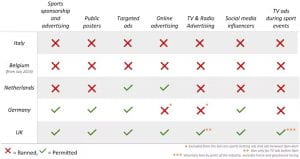By Dr Raffaello Rossi, Lecturer in Marketing
 In 2020, the UK government announced an overhaul of the Gambling Act to make the laws “fit for the digital age”. Having spent a couple of years researching gambling ads on social media – I thought: “wow, this is exactly what we need” – not only because our own research had shown:
In 2020, the UK government announced an overhaul of the Gambling Act to make the laws “fit for the digital age”. Having spent a couple of years researching gambling ads on social media – I thought: “wow, this is exactly what we need” – not only because our own research had shown:
- 1m UK gambling ads per year on Twitter only,
- Two-thirds of all gambling accounts followers online are under 25,
- Gambling ads on social media are highly appealing to children – but not to adults, and that
- During one weekend, gambling ads on X (Twitter) reap an incredible 34 million views – putting social media marketing now at the heart of the industries marketing efforts.
However, my enthusiasm waned when the Gambling Act Review White Paper was unveiled in April 2023. Surprisingly, it lacked in actual interventions around (online) gambling marketing, and did not follow what most of our European neighbours have recently done. Whilst Belgium and Italy have recently almost entirely banned gambling marketing, Germany and Netherlands have intervened in several key areas – making Great Britain increasingly an outliner by allowing almost all forms of gambling marketing with minimal restrictions on online efforts.

Source: Rossi, R., Nairn, A., Ford, B., and Wheaton, J. (2023). Gambling Act review: how EU countries are tightening restrictions on ads and why the UK should too. The Conversation. UK.
The challenges of regulating online advertising
The core challenge lies in the fundamental differences between online and offline marketing, rendering our current regulatory framework, rooted in the offline world’s regulations from the 1960s, inadequate and unable to work efficiently. Online marketing presents distinct features that require tailored regulations, and I’d like to highlight three crucial differences:
Firstly, the advent of “targeted ads” – enables incredible precise demographic targeting, surpassing traditional marketing capabilities. This enables brands, for example, to show ads only to males, age 18-25, that play football, and follow sports-related accounts online. This targeting far exceeds the possibilities of traditional marketing, and if not restricted, could enable gambling brands to focus their marketing communications on young and vulnerable audience – who, from a business point of view, is the most lucrative audience.
Secondly, the transient nature of online ads, such as “stories” or paid-for ads, poses a challenge to accountability. Unlike TV commercials with a centralised database were ads are stored, there’s no mechanism to store and monitor online ads. Once they are gone (e.g. after 24h for stories, or after being deleted by the account) – they are gone! So, how is this policed? Currently, we are mainly relying on users to report potential breaches. This means users need to act quickly when encountering a suspicious gambling ad, screenshot the ad, and finally, report it the Advertising Standards Authorities. However, I don’t think many people do so. But, what this means, is that the lack of policy in place to deal with this systemically, has created a “dark space” where advertising may go unchecked. In other words, I believe, that neither researchers, policy-makers nor enforcement officers at the ASA have a clue of what is actually happening out there, as we do not have the provisions to monitor it.
The final challenge stems from the unprecedented volume of online and social media advertising. With 1 million unique UK gambling ads on Twitter alone, the sheer diversity of content makes policing and monitoring a daunting task. With AI coming into the mix – as Edoardo Tozzi has shown – this might make things even worse. So far, gambling brands’ main costs in creating their 1m ads per year has been paying for their staff to design them. Now, with AI being able to create ads within seconds, soon we might not see 1m ads per year, but 10-times or 100-times as much – there is virtually no limit. And no policies in place that would protect us.
So, where are we going from here?
Well, first of all, I believe we need to start accepting that online marketing is so fundamentally different, that our old laws and regulations don’t work. What should follow is the introduction of online specific marketing regulations. However, I also believe that we need to start facing an uncomfortable truth: we need to start regulating the volume of (gambling) marketing, as opposed to solely focusing on the content. Because even if the 100m AI-generated ads adhere to all regulations, do we really want to see our world plastered in gambling ads?
Reposted from the University of Bristol Business School blog

